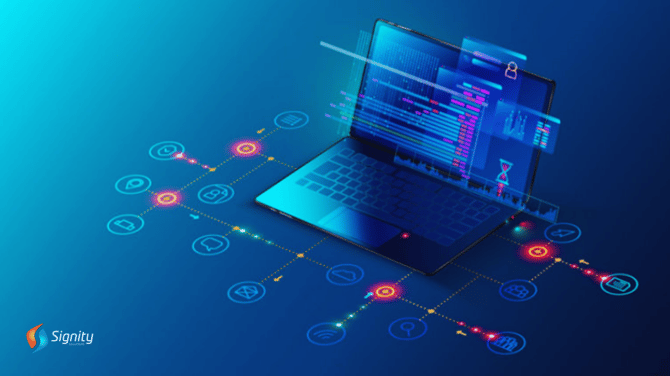Agile Software Development - Why are Developers Adoring it?
Agile software development has gained popularity among developers due to its flexibility, collaboration, and iterative process. By breaking projects into smaller tasks, teams can quickly adapt to changes, deliver faster, and ensure better quality through continuous feedback, making it a favorite approach in software development.

Project management is difficult. It consumes efforts, time, cost, and tons of tools and technologies to deliver a product that contents the customers. There’s rarely a development process that scrutinizes performance at every level. Or, there is? Agile software development seems to fit the requirements.
This method has grown significantly in recent years. So, without much ado, let’s get into knowing agile software development and the way it works!
What is Agile Software Development?
In general, Agile means the flexibility to change or respond to change. Agile Software development, on the other hand, is the process that creates MVPs or Minimum Viable Products after undergoing a few repetitions till the appropriate solution is achieved.
Furthermore, agile software development is not just the frameworks, including Extreme Programming or Scrum. It even works on test-driven development, planning sessions, pair programming, sprints, and more. It is just like a giant umbrella covering all sets of frameworks & practices expressed in the Manifesto for Agile software development.
It is like a giant umbrella covering all the frameworks and practices expressed in the Manifesto for Agile software development. Within this broad methodology, frequently used test automation tools become essential components, facilitating the rapid iteration and refinement that Agile principles advocate. These tools allow teams to implement continuous testing with each sprint, ensuring that each iteration of the product not only meets the minimum viability but also adheres to quality standards.
The process involves a steady iteration of development and testing through the entire journey of the software development process.
Agile Manifesto Principles: The Values and The Principles
Wondering what is an agile manifesto? Well, it is a brief document developed keeping in mind the 4 values and 12 principles, published in February 2001.
It is a collaborative document created by 17 software development practitioners, who assessed and understood the accelerating demand for a reliable and powerful alternative to traditional software development processes.
The agile manifesto offers complete guidance on how to follow a seamless and much more effective agile development process. Let’s understand the core value and principles of Agile Software Development first so that we know how it functions.
4 Core Values of Agile Software Development
The agile software development process rests on these four core values:
1. Team Communication & Interaction over Tools
During agile software development, individual interactions are way more important than the tools and processes. People are the most important part of agile development. They drive the development process and act to fulfill the business needs. Alternatively, when the development process is led by tools and processes, the interaction between team members is lower. That means teams are less likely to respond to change. Hence, lower customer needs are fulfilled.
2. Focus on Working Software rather than Preparing Comprehensive Documentation
Businesses focused on developing huge documentation rather than focusing on working software. Since that used to consume hours and hours, a delay in the development process was expected. However, agile software changed the scenario. Agile focuses heavily on delivering the right information to developers for more streamlined work. It doesn’t eliminate the entire documentation process; just focuses on the information actually needed.
3. Collaboration between Customer and Project Manager Instead of Contract Negotiation
Better collaboration between the customer and project manager ends up in quicker development. The participation of customers in the entire development journey means knowing what they need. That’s an easy way to deliver as per the customer’s expectations. Customer interaction could be on a daily basis or at different intervals, as required.
4. Focus on Responding to Change rather than Following a Plan
Traditional development methods never focused on change. For those interested in enhancing the flexibility and effectiveness of Agile processes with advanced project management skills, pursuing a master's in IT project management program can be highly beneficial. This type of educational program is designed to elevate how project managers navigate complexities within methodologies such as Scrum, Lean Development, and XP. Integrating these skills ultimately enhances team performance and project outcomes.
It was seen as an unwanted expense. However, agile development eliminates the idea of an ‘unchanged’ development process. Agile allows quick changes that help the team alter the process to fit the expectations of the customers. With agile, it can be said that change can improve the overall project and bring more value to the end results.
12 Agile Software Development Principles
The agile software development process acts on the basis of these twelve principles, which are:
- Satisfy the customer via timely and continuous delivery of valuable products.
- Accept change is a must in the development process, right from the beginning till the end.
- Give preference to shorter delivery times. Deliver working software frequently from a couple of weeks to months.
- Project managers and customers must work together more often to get expected results.
- Give developers a comfortable environment, where they are motivated to work. They need a trustworthy environment to work in.
- Face-to-face conversations are the best way to convey information to and within the development team.
- The development progress depends on working software.
- Sustainable development processes can be expected using agile methodologies.
- Developers, customers, and sponsors need to be on the same page for successful product delivery.
- Constant attention to technical details and excellent design result in more agility.
- Simplify tasks, break them into smaller tasks, and test them frequently for maximizing efficiency.
- Self-organized teams result in the best designs and architectures. At short intervals, quality check helps build more effective and efficient products.
Well, it seems agile has a robust basis of principles and core values. The constant interaction with customers, developers, and testers result in a highly satisfying end result. Also, the set principles are quite customer-oriented, which seems to be a sure-shot way to focus on building what is appreciated by the end-user.
But, how does the development team work? What is the process that they follow to build such contenting results?
Let’s explore!
Agile Software Development Methodology - The Process
There are various agile methods used in agile testing. All these methodologies are designed keeping in mind the attention to detail and focus to build products that satisfy the end-user.
Learn more about these methodologies, as we have listed all the primary ones here:
- Scrum
- Crystal Methodologies
- Dynamic Software Development Method (DSDM)
- Feature-Driven Development (FDD)
- Lean Software Development
- Extreme Programming (XP)
1. Scrum
An agile development methodology that relies on task management in an environment that focuses on team-based development. This technique helps empower all developers, testers, and advocates working on bigger tasks broken into smaller ones. To ensure clear visibility and coordination of tasks, teams often use a scrum board online, promoting efficiency in the development process.
- Scrum Master - Master sets up teams, sprint meetings, cut off potential hindrances.
- Product Owner - Creates backlog, prioritizes it, and delivers functionality at every stage.
- Scrum Team - Team handles all the work assigned and manages the complete sprint cycle.
2. Crystal Methodologies
This methodology is based on three basic concepts:
- Chartering - Building development team, developing a plan, and tuning development methodology.
- Cyclic Delivery - Responsible for refining the initial plan, test the first stage design, check whether the integrated product reached the users, review the plan and apt development methodology.
- Closing - Products deployed to users. Receive deployment reviews and reflections.
3. Dynamic Software Development Method (DSDM)
A Rapid Application Development approach that requires the users to actively participate in the process. They have the opportunity to make decisions. Frequent product delivery along with constantly required modifications is the focus of the Dynamic Software Development Method.
4. Feature-Driven Development (FDD)
The method revolves around building features and designing them well. It describes bite-sized tasks that are specific to the requirements and has to be obtained individually. It includes tasks like code inspection, code design, and design inspection. FDD considers factors such as feature teams, inspections, development by features, regular design-build, constant progress check, and configuration management.
5. Lean Software Development
It follows the mantra, ‘just in time production.’ The purpose of Lean Software Development is to amplify the speed of software development, without investing too much in the cost spent. This method aims at eliminating waste, quick deliveries, improving learning, empowering the team, delivering before commitment, building team collaboration, and optimizing everything.
6. Extreme Programming (XP)
The technique steps in to solve the constantly changing demands of the customers, especially when they are unsure about the expected functionality of the product. Hence, XP releases short cycles with frequent checkpoints to ensure what’s delivered is effective and valuable. Most importantly, it should match customer expectations. Hence, the software is built keeping customers as the target.
So, now we clearly understand what agile is and how it works. We also understood what processes go into delivering a superb product that matters for the customers. Let’s look into the complete agile software development lifecycle to understand how it works right from the beginning till the end.
The Agile Software Development Cycle
Regardless of what you are using, Scrum, Feature-Driven Development, or any other agile methodology, the basic agile approach remains constant. That doesn’t change.
Here’s the agile software development cycle followed to develop high-end products for the end-users:
- Begin the project.
- Define what is the project about and what is to be accomplished.
- Prepare guidelines for the project.
- Create a software function.
- Integrate the function that you designed.
- Test the function created and integrated into previous steps.
- Once the tests are successfully completed, proceed to the next function and test it to see how it functions.
- If the test doesn’t work appropriately, it is suggested to go back to the entire process to see what went wrong during the implementation process.
- With constant team interaction and customer involvement, prioritize changes.
- Test again all the changes before you finally release it in the market.
- Proceed to the next function and repeat the same process of creating, integrating, and testing functions until everything is accomplished.
Now, we pretty much know how the agile software development process works. But then it is not the only option that’s available for the development team. A popular alternative, called the Waterfall Model also exists.
Don’t worry, there will be no confusion once you know the difference between both agile and waterfall models. Also, it will be easier for you to understand when to select which methodology to deliver the results that customers want.
Agile Model vs. Waterfall Model: Which is Better for Your Project?
The waterfall model for software development is simple. It begins with requirements, proceeds with design, implementation, verification, and maintenance. There is no stop, check, and modify approach in this model, unlike the agile development process.
Though both the models follow different approaches, one can’t overpower the other. Both these models play their own roles in different types of projects. You will have a clear perspective of both of them once you go through this table.
| Agile Model | Waterfall Model |
| Agile development breaks bigger processes into individual models so that designers can easily complete bite-sized tasks and test it before proceeding. | No such breaking of design takes place in the waterfall model. |
| Customers have the privilege to check the product at early stages, meaning potential changes can be done to match it as per customer’s expectations. | Customers have no option of seeing the product before it is finally published in the market. |
| Many consider agile software development models an unstructured model as compared to the waterfall model. The flexibility to change makes people think of the agile model as more unstructured. | The waterfall model for development is considered safer since it is planned and proceeds strategically unlike the agile model. |
| It supports error fixing at any time of the development stage. | It is only at the end that the entire product is tested. If any requirement error is found, then the entire project needs to start again. |
| Lengthy documentation is not the priority here, however it is not completely ignored. | Documentation is the priority here and used to train the team or upgrade the software. |
| Developers, customers, and testers work together to build a product. | Developers do not work closely with the testers. Both work separately to deliver a product. |
| Smaller projects are delivered very quickly. However, larger projects consume more time. It is tough to estimate the exact development time, as frequent modifications and testing are done. | No matter the small or the large project, everything is completed on time and without any additional modifications. |
| On completion of every function, the progress is tested thoroughly to figure out the possible errors. After short intervals, everything is tested and modified. | User acceptance is done at the end of the development process. No testing and amendments are done in between. |
| Developers work closely with testers and customers. Hence, it is easy to analyze planning and requirements. | Developers are not involved in planning. Also, there is no involvement of customers in the entire process. Hence delayed time can be expected between coding and tests. |
After a thorough comparison, we can see that both agile and waterfall come with their own upsides and downsides. The waterfall model is more planned and systematic, however agile is not. Agile is more inclined towards customer interference, modifications, and testing at short intervals.
Since we are focusing on how agile development works and why developers are adoring it, it is essential to mention some benefits that agile development can bring into your project.
Why Agile Software Development? The Benefits Explained
The market is changing rapidly, customer satisfaction is the priority now. Why everyone is prioritizing agile software development is due to its flexible nature and ability to adapt to current market trends. If needed, it changes the plan, almost instantly.
Here are some benefits of agile development, which are worth mentioning:
1. Higher Customer Satisfaction Rate
Who doesn't want to keep their customers content? Everyone is trying to impress their end-users. Agile methods involve and inform customers right from the beginning. The chances of success are higher here. Why? Because everything is done keeping customers in the loop. Besides, frequent testing and feedback from customers allows delivering better results, and more like what customers expected. Hence, reduced chances of customer dissatisfaction.
Agile methods have significantly influenced the way software development teams approach project management by enabling earlier issue detection and streamlined workflows. To further enhance your team's effectiveness, you can build a shift-left strategy that strengthens security management by integrating security considerations at every stage of the Agile process.
Agile methods have significantly influenced the way software development teams approach project management by enabling earlier issue detection and streamlined workflows. To further enhance your team's effectiveness, you can build a shift-left strategy that strengthens security management by integrating security considerations at every stage of the Agile process.
2. Extreme Flexibility & Control
Product owners review everything and control every activity of the project. Constant feedback, improvement, and planning to create something better is possible when you opt for agile software development. That’s why organizations prefer it over a waterfall - the flexibility and adaptability to change matter in business now.
3. Higher Product Quality
Agile software development focuses on improving the quality of products at every stage. It focuses on bringing value to the project right from the beginning. Once you have completed one sprint, it will be tested and checked. When everyone involved will be satisfied with the first step, only then the next level is commenced. Hence, there is no scope of any mistake or error when you opt for agile software development. Since everything is checked multiple times and tested to match the expectations, the final product that is delivered is high quality.
Last But Not The Least!
Agile software development is getting an upper hand now. It all started in 2015 and since then this method has been in the good books of developers. The primary reasons why agile development is highlighted is that:
- It is highly flexible
- It involves customers/end users in the development process.
- Delivers high-quality products
- High customer satisfaction
The four core values and twelve robust principles ensure that scrutinization happens at every stage. Developers, testers, and customers build together to deploy a product likable to the end-user. And, that’s the ultimate goal of any business - to satisfy the expectations of the customers.
Hence, the agile development process is worth a try for your next project!













